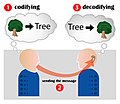Structured literacy (SL), according to the International Dyslexia Association (which coined the term), is the systematic teaching of reading that focuses on the following elements: [7]
Contents
- Phonology: the sound structure of spoken words and Phonemic awareness (the ability to recognize, segment, blend, and manipulate sounds)
- Sound-symbol association (also Phonics): using the Alphabetic principle to connect sounds (phonemes) to letters (graphemes)
- Syllables: part of a word with one vowel sound, with or without a consonant (e.g., The word reading has two syllables, "read" and "ing".)
- Morphology: the smallest unit of meaning in a language (e.g., The word unbreakable has three morphemes, "un", "break", and "able".)
- Syntax: grammar, sentence structure, etc.
- Semantics: meaning.
SL is taught using the following principles: [1]
- Systematic: begin with the basic and easiest concepts and elements, and progress to the more difficult and complex
- Cumulative: each step builds on a previous step
- Explicit: direct teaching and continuous teacher-student interaction
- Multisensory: using different senses (e.g., visual, auditory, kinesthetic, and tactile) to enhance attention and memory
- Diagnostic: using informal and formal assessments to individualize instruction
The International Dyslexia Association provides a detailed outline of its Key Performance Standards of its Knowledge and Practice Standards for Teachers of Reading. [8]
There is general agreement that SL is beneficial for all early literacy learners, especially those with reading disabilities such as dyslexia. [14] However, according to professor Mark Seidenberg, while SL is necessary for students with special needs (e.g., to overcome dyslexia), it may not be required for the general student population beyond the early literacy years. He suggests that teachers strike a balance between implicit instruction and explicit instruction, with explicit instruction for all students at the start, followed by implicit instruction for all students except dyslexics (who continue to receive explicit instruction as required). [15]

